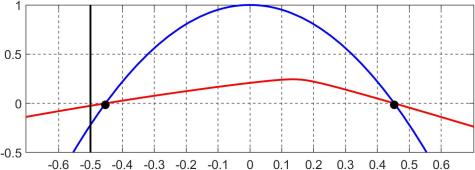Does a symmetric positive definite matrix remain positive definite when we set one or more elements to zero? This question arises in thresholding, in which elements of absolute value less than some tolerance are set to zero. Thresholding is used in some applications to remove correlations thought to be spurious, so that only statistically significant ones are retained.
We will focus on the case where just one element is changed and consider an arbitrary target value rather than zero. Given an symmetric positive definite matrix
we define
to be the matrix resulting from adding
to the
and
elements and we ask when is
positive definite. We can write
where is the
th column of the identity matrix. The perturbation
has rank
, with eigenvalues
,
, and
repeated
times. Hence we can write
in the form
, where
and
. Adding
to
causes each eigenvalue to increase or stay the same, while subtracting
decreases or leaves unchanged each eigenvalue. However, more is true: after each of these rank-
perturbations the eigenvalues of the original and perturbed matrices interlace, by Weyl’s theorem. Hence, with the eigenvalues of
ordered as
, we have (Horn and Johnson, Cor. 4.3.7)
Because is positive definite these inequalities imply that
, so
has at most one negative eigenvalue. Since
is the product of the eigenvalues of
this means that
is positive definite precisely when
.
There is a simple expression for , which follows from a lemma of Chan (1984), as explained by Georgescu, Higham, and Peters (2018):
where . Hence the condition for
to be positive definite is
We can factorize
so for
where the endpoints are finite because , like
, is positive definite and so
.
The condition for to remain positive definite when
is set to zero is
, or equivalently
. To check either of these conditions we need just
,
, and
. These elements can be computed without computing the whole inverse by solving the equations
for
, for the
th column
of
, making use of a Cholesky factorization of
.
As an example, we consider the Lehmer matrix, which has
element
for
:
The smallest eigenvalue of is
. Any off-diagonal element except the
element can be zeroed without destroying positive definiteness, and if the
element is zeroed then the new matrix has smallest eigenvalue
. For
and
, the following plot shows in red
and in blue
; the black dots are the endpoints of the closure of the interval
and the vertical black line is the value
. Clearly,
lies outside
, which is why zeroing this element causes a loss of positive definiteness. Note that
also tells us that we can increase
to any number less than
without losing definiteness.

Given a positive definite matrix and a set of elements to be modified we may wish to determine subsets (including a maximal subset) of
for which the modifications preserve definiteness. Efficiently determining these subsets appears to be an open problem.
In practical applications thresholding may lead to an indefinite matrix. Definiteness must then be restored to obtain a valid correlation matrix. One way to do this is to find the nearest correlation matrix in the Frobenius norm such that the zeroed elements remain zero. This can be done by the alternating projections method with a projection to keep the zeroed elements fixed. Since the nearest correlation matrix is positive semidefinite, it is also desirable to to incorporate a lower bound on the smallest eigenvalue, which corresponds to another projection. Both these projections are supported in the algorithm of Higham and Strabić (2016), implemented in the code at https://github.com/higham/anderson-accel-ncm. For the Lehmer matrix, the nearest correlation matrix with zero
element and eigenvalues at least
is (to four significant figures)
A related question is for what patterns of elements that are set to zero is positive definiteness guaranteed to be preserved for all positive definite ? Clearly, setting all the off-diagonal elements to zero preserves definiteness, since the diagonal of a positive definite matrix is positive. Guillot and Rajaratnam (2012) show that the answer to the question is that the new matrix must be a symmetric permutation of a block diagonal matrix. However, for particular
this restriction does not necessarily hold, as the Lehmer matrix example shows.
References
- Tony F. Chan, On the Existence and Computation of
-Factorizations with Small Pivots, Math. Comp. 42(166), 535–547, 1984.
- Dan I. Georgescu, Nicholas J. Higham, and Gareth W. Peters, Explicit Solutions to Correlation Matrix Completion Problems, with an Application to Risk Management and Insurance, Roy. Soc. Open Sci. 5(3), 1–11, 2018
- Dominique Guillot and Bala Rajaratnam, Retaining Positive Definiteness in Thresholded Matrices, Linear Algebra Appl. 436(11), 4143–4160, 2012.
- Nicholas J. Higham and Nataša Strabić, Anderson Acceleration of the Alternating Projections Method for Computing the Nearest Correlation Matrix, Numer. Algorithms 72(4), 1021–1042, 2016. Sections 3.1, 3.2.
- Roger A. Horn and Charles R. Johnson, Matrix Analysis, second edition, Cambridge University Press, 2013. My review of the second edition.
